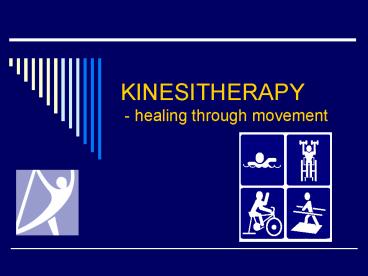KINESITHERAPY - healing through movement - PowerPoint PPT Presentation
1 / 32
Title:
KINESITHERAPY - healing through movement
Description:
KINESITHERAPY - healing through movement Content of lecture definition history subject and aim principles methods contraindications What is happening in our lives ... – PowerPoint PPT presentation
Number of Views:663
Avg rating:5.0/5.0
Title: KINESITHERAPY - healing through movement
1
KINESITHERAPY - healing through movement
2
Content of lecture
- definition
- history
- subject and aim
- principles
- methods
- contraindications
3
- What is happening in our lives is less important
real question if we will use this experience for
our growth
4
- Corrective gymnastics
- Medical gymnastics
- Therapeutic gymnastics
- Orthopedic gymnastics
- Kinesitherapy
- Kinesiotherapy
5
Definition
- Kinezitherapy - the therapeutic and corrective
application of passive and active movements and
of exercise - Greek-
- Kinessismovement, motion
- Therapietherapy
6
- part of Kinesiology
- part of Medical science one of the method in
Physical medicine and rehabilitations - Interdisciplinary approach
7
HISTORY OF DEVELOPMENT OF KINESITHERAPY
- China - 2700 BC -book Kong-Fu elements of
therapeutic gymnastics -describes the active,
passive and combined exercises and massage - Chinese physician - Hua Tuo - medical Daoyin
exercise
8
- Chinese believed the most important aspect of
disease is prevention medicine - "This doctor is not who heals the sick, is who
prevents the disease - Tai ji quan
9
- In ancient India, yogis have used at least 800 of
breathing exercises - with the help of these
exercises are prevented and treated disease
10
- Ancient Greece - Merodik, Hipokrat, Asklepiad -
exercise are compulsory part of prophylaxis - 300 years B.C., Aristotle termed the word
kinesiology and is often referred to as the
Father of Kinesiology
11
- Archimedes was the first to develop principles of
fluid mechanics - Galen was a Roman physician for gladiators often
known as the first athletic team physician
12
- In ancient Rome, therapeutic exercise was
particularly well developed - K. Galen used the gym for the treatment and
prevention of diseases of bone and muscular
systems, - among other things, from a therapeutic purpose,
he ordered the sports exercise (rowing, walking
outdoors, etc. ) - In its edition of "The Art of return to health" -
"Thousands and thousands of times I was returning
health to their patients through exercise."
13
- Abu Ali Ibn Sina (Avicenna) in his book "Canon of
Medicine" and "Book of Healing" describes in
detail the treatment and prevention of various
diseases with the help of medical gymnastics
14
- Nikolas Andry, French physician,
- Andry published his introduction to orthopedics
in 1741. under the title Orthopédie - teach the different Methods of preventing and
correction of Deformities of Children
15
- Per Henrik Ling (1776 1839) was a Swedish
physical therapist, developer and teacher of
medical-gymnastics - Ling's system of medical gymnastics also
influenced later institutions and systems. The
Gymnastic Orthopedic Institute was founded in
Stockholm in 1822
16
- In 1780. the published work of Tissot "Medical
gymnastics, or exercise of human organs under the
laws of physiology, hygiene and therapeutics, it
sets out descriptions of various physical
exercises, massage (rubbing) as well as their use
for treating all sorts of diseases.
17
OBJECTIVE OF KINESITHERAPY
- Through different kinesiological models and
exercises improve health
18
- PREVENTIVE
- CORRECTIVE
- CURE
Possibilities
19
BASIC OPERATORS IN KINESITHERAPY
- MOVEMENT - EXERCISE
- PASIVE
- SUPPORTING
- ACTIVE
- ACTIVE WITH WEIGHT
- STATIC
- DYNAMIC
20
SECONDARY OPERATORS IN KINESITHERAPY
- physical resources
- massage
- manipulation
- electric and mehano devices
21
- PHYSICAL THERAPY - (or physiotherapy), often
abbreviated PT, is the art and science of
physical care and rehabilitation - to develop, maintain and restore maximum movement
and functional ability - Functional movement is central to what it means
to be healthy
22
- Physical therapy is concerned with identifying
and maximizing quality of life and movement
potential within the spheres of - promotion
- prevention
- treatment/intervention
- habilitation
- rehabilitation
23
PHYSICAL THERAPY
- Hydrotherapy - use of water for pain relief and
treating illness, - using jets, underwater massage and mineral baths
(balneotherapy, thalassotherapy) - Thermotherapy - is the application of heat to the
body - hot cloth, hot water, ultrasound, heating pad,
paraffin
24
- Phototherapy or Light therapy (heliotherapy)
consists of exposure to daylight or to specific
wavelengths of light using lasers, light-emitting
diodes, fluorescent lamps, diachronic lamps or
very bright, full-spectrum light - Electrotherapy is the use of electrical energy as
a medical treatment - Ultrasound
25
- Magnet therapy, (magnetic therapy, or
magnotherapy)- involving the use of static
magnetic fields
26
PRINCIPLES OF KINESITHERAPY
- Principle of motivation
- Principle of early beginning
- Principle of analyze of exercise
- Principle of understanding exercise
- Principle of avoiding the pain
- Principle of gradually
27
- Principle of pragmatically
- Principle of continues of exercise
- Principle of active involvement of participant
- Principle of persistence
- Principle of avoiding monotony
- Principle of following and recording of results
28
METHODS OF WORK
- Movement
- Exercise
- Sport games
- Elements of sports
29
ORGANIZATION FORMS OF WORK
- Individual
- Group exercise
30
INDICATIONS
- Areas
- Cardiopulmonary
- Geriatric
- Neurological
- Orthopedic
- Pediatric
- Orthopedic
31
CONTRAINDICATIONS
- infectious disease
- febrile
- malignant disease
- inflammation process in the body
32
- Questions??????
Thank you for your attention































